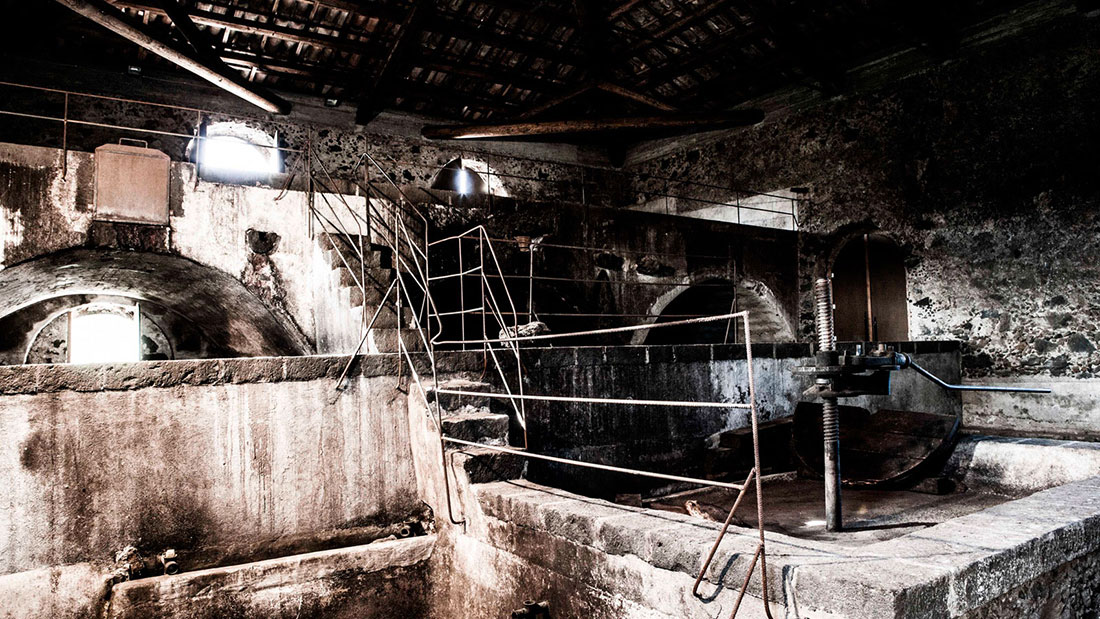Blog
The Palmento. The short story of a rural masterpiece
To understand what a palmento is, we must start with a definition.

The term «palmento» refers to a large and shallow tank carved from the rock or made with brick or concrete. This was used for crushing and fermenting must and was common in southern Italy, particularly in Sicily.
The term «palmento» refers to a large and shallow tank carved from the rock or made with brick or concrete. This was used for crushing and fermenting must and was common in southern Italy, particularly in Sicily. But palmento also refers to a «grinder», specifically to the stone used by mills to crush cereals and turn them into flour. The latter definition is the origin of the saying «macinare a quattro palmenti» (lit. “to grind using four millstones”), also commonly expressed as «mangiare a quattro palmenti» (lit. “eating from four millstones), which means “to eat greedily, in a gluttonous manner”.
But linguists are still debating: where exactly does this controversial term come from? The most obvious answer would bring us to the Latin word «pavimentum», which refers to the place where crushed or ground agricultural products (grapes or cereals) would be placed.
This Latin term is what interests us as it closely points to what was historically called a “stone palmento”. The first examples of these “floors carved into the rock” date back to the Bronze Age and are present throughout the Mediterranean. In Sicily, some examples can be found in the area of Alcantara up to the lands surrounding Mt. Etna. These are truly astonishing artifacts: pits dug from the sandstone by hand and utilized for crushing grapes, an unmistakable proof of the ancient bond shared by Sicilian civilizations with vine cultivation and wines.
THE STONE PALMENTO
This type of palmento was made up of two basins, which were placed on different heights, connected by a hole. These were built in the countryside, near cultivated fields and in areas where impermeable rocks were present. The upper tank was where the grapes were crushed; the must would then fall into the lower tank for fermentation. The grapes were probably pressed with the feet, but designated presses could have also been later used. Today, these stone structures are being rediscovered and enhanced: there are specific itineraries that allow to explore these constructions. One of the oldest palmento in Sicily dates back to more than 2,500 years ago and is located in Sambuca di Sicilia, in the heart of the Terre Sicane.
THE MODERN PALMENTO
The simple yet effective structure of the stone palmento was maintained in creating more modern models. These structures are the most typical rural constructions of the Etna territory from the Middle Ages up until the late 20th century. The steep and sharp conformation of the land allowed to replicate ancient pressing methods and structure the cellar on several levels, making use of the natural inclination of the volcano and the force of gravity to put the must in motion. The modern palmento has a large stone or concrete tank where the grapes were collected following harvest. The fruits would be pressed using the feet (pista) and the wine must would flow through a system of channels made in stone (cannedda) towards the fermentation vats (ricivitùri). After fermentation, the wine would proceed towards the aging barrels located in the lowest place of the cellar, called ispensa. This process does not make use of mechanical pumps or manpower: the force of gravity and the system of communicating tanks were all that was needed!
PALMENTO COSTANZO
The Palmento acquired by the Costanzo family underwent a conservative restoration process. To respect the multi-level structure, the technological integrations have been adapted in order to maintain the traditional production process without altering the space at hand. Today, an area dedicated to grape pressing and fermentation, which is carried out in truncated conical oak vats, can be found where the pista once was performed. Underneath are the stainless steel containers, while the barrel room is situated on the ground floor. Just like two millennia ago, the process employs the force of gravity and does not use pumps for pumping over. This preserves fruit integrity and maintains the natural expressiveness of the grapes.
